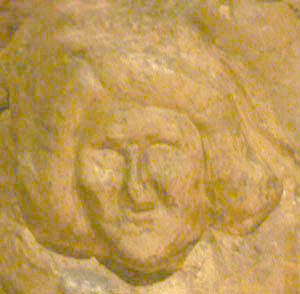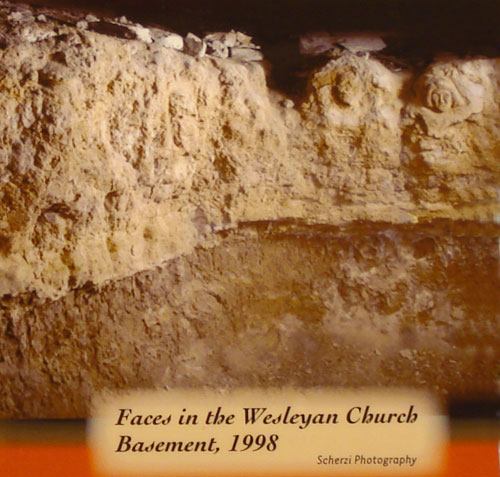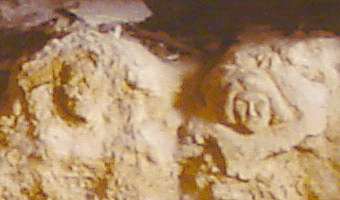|
Freedom Bound - The Story of Syracuse & The Underground Railroad:
What Do You Think?
Responses left on c oment cards from some of our museum visitors.
 Comments from a very young boy named Adam: Comments from a very young boy named Adam:
Who might the carved faces represent?
Family members
What do the faces or the exhibit make you think about?
Sad faces
Who might the carved faces represent?
People they knew or wanted to remember or maybe even their own.
What do the faces or the exhibit make you think about?
Just slavery and its wrongs.
Who might the carved faces represent?
People they left behind.
What do the faces or the exhibit make you think about?
A slave keeper.
Who might the carved faces represent?
Harriet Tubman
What do the faces or the exhibit make you think about?
Freedom!!!
Who might the carved faces represent?
Escaped slaves and/or freedom helpers
What do the faces or the exhibit make you think about?
How indeed the times have changed and how hard it definitely was during slavery.
Who might the carved faces represent?
The carved faces might be the faces of the people that the slaves loved.
What do the faces or the exhibit make you think about?
It makes me think about Harriet Tubman.
From Madeline T.
Who might the carved faces represent?
Hopeful people who were looking for a place that would accept them unconditionally.
What do the faces or the exhibit make you think about?
It is amazing that so many good hearted people settled in this area. God had a plan for all of them.
Who might the carved faces represent?
Escaping slaves.
Escaping slaves' wives/mothers
Escaping slaves' etc.
What do the faces or the exhibit make you think about?
Slaves hiding to be free for days on end. . .
Who might the carved faces represent?
People trying to find their way out.
What do the faces or the exhibit make you think about?
What if I was in the same situation.

Who might the carved faces represent?
(No response)
What do the faces or the exhibit make you think about?
I think it is incredible that not many people know about how influential Syracuse, NY was in the fight against slavery.
Who might the carved faces represent?
The carved faces represent the men and women who sacrificed their lives for our freedom.
What do the faces or the exhibit make you think about?
How unfairly these people were treated, and what would I do if I was them.
Who might the carved faces represent?
A sign that slaves were here. The people who escaped on the Underground Railroad or the people who helped them.
What do the faces or the exhibit make you think about?
How awful it must have been to be in slavery and have to escape on the underground railroad.
Who might the carved faces represent?
Family members.
What do the faces or the exhibit make you think about?
If they missed each other or were scared.
Who might the carved faces represent?
Likenesses of those who were either supporters of the ongoing struggle for freedom or those preserving to seek freedom themselves.
What do the faces or the exhibit make you think about?
The awesome reality that the struggle was alive and well.
Who might the carved faces represent?
All of the people who suffered from oppression.
What do the faces or the exhibit make you think about?
The great history of Syracuse that many people are not aware of.
Who might the carved faces represent?
Relatives.
What do the faces or the exhibit make you think about?
History and how important it is to never forget.
Who might the carved faces represent?
The runaway slaves.
What do the faces or the exhibit make you think about?
The past life for African American slaves, and how hard their lives were.
Who might the carved faces represent?
People who came here years ago.
What do the faces or the exhibit make you think about?
Fresh air and sunshine!
Who might the carved faces represent?
Could represent family members that previous runaways missed or they attempted to do self portraits.
What do the faces or the exhibit make you think about?
Makes me think about how my people struggled to be free.
 Who might the carved faces represent? Who might the carved faces represent?
I think it represents slaves on the run. To show slaves that the house that they go to are good people.
What do the faces or the exhibit make you think about?
About all of the slaves and how they were treated and stuff.
Who might the carved faces represent?
Their loves ones left behind.
What do the faces or the exhibit make you think about?
My children and grandchildren – they are of mixed racial heritage. I will bring them here to see the exhibit.
Who might the carved faces represent?
Probably the tired, sick, hungry, freedom-desperate slaves.
What do the faces or the exhibit make you think about?
The horrible life of these slaves and what they had to do to get freedom.
Who might the carved faces represent?
They are a metaphor for the strength of people seeking the freedom that was their right.
What do the faces or the exhibit make you think about?
It is a compelling and sobering look at their struggle for freedom.
From Rebecca R.:
Who might the carved faces represent?
I think they represent the help from the people in the church and how they now know tha the slaves were there.
What do the faces or the exhibit make you think about?
How treacherous the journey for the slaves was.
Who might the carved faces represent?
A constant reminder of death, sorry and the true sense of things people take for granted, FREEDOM.
What do the faces or the exhibit make you think about?
Freedom. It is never free. You can feel the sense of lose from their families, home and life.
Who might the carved faces represent?
I think the carved faces might represent relatives left behind in bondage. That might be reason why they're not smiling.
What do the faces or the exhibit make you think about?
The exhibit faces made me think about how hard it was probably for them and how brave they were.
Who might the carved faces represent?
I think the faces were carved to represent the slaves that tried to fight for freedom.
What do the faces or the exhibit make you think about?
I think of the things they had to go through, and how they got shot if they didn't listen to what they were told.
Who might the carved faces represent?
It is the people who helped them.
What do the faces or the exhibit make you think about?
I think it's sad because they shot them.
Who might the carved faces represent?
The carved faces are boys.
What do the faces or the exhibit make you think about?
I think it's sad.
Who might the carved faces represent?
I think they represent the fleeing slaves and were a symbol of hope that they would be freed.
What do the faces or the exhibit make you think about?
The faces made me think about how horrible slavery is.
Who might the carved faces represent?
Slave workers.
What do the faces or the exhibit make you think about?
Makes me think about USA history like without the slaves. USA couldn't be as far in economies(?) like we are today.
How might the carved faces represent?
Helen Ameila
What do the faces or the exhibit make you think about?
Risks, secrets, and all the fears of escaping just for basic human freedom.
How might the carved faces represent?
I feel they represent the many different faces that were searching to be free.
What do the faces or the exhibit make you think about?
It makes me think about how much hatred existed then and how much has changed in regards to freedom, however, the fight still exists to be truly free.
How might the carved faces represent?
Might be drawings children made to stay silent and entertained. Just like we do with our children today. We let them draw to express emotion or clear boredom.
What do the faces or the exhibit make you think about?
We think of all the slaves but not much of the children slaves. Children who had their innocence stolen.
How might the carved faces represent?
It might be their own faces.
What do the faces or the exhibit make you think about?
They make me think about the artists trying to carve their faces for the future to see.
How might the carved faces represent?
The slaves that escaped from the south came up to the north for freedom.
What do the faces or the exhibit make you think about?
This makes me think about all of the free time and how I spend it versus the slaves carving their faces and leaving their markings.
How might the carved faces represent?
What do the faces or the exhibit make you think about?
I am proud that my ancestors are a part of this exhibit and history of this long struggle. Great, great, great granddaughter of Frank Wonzer.
How might the carved faces represent?
Lost souls of African-Americans
What do the faces or the exhibit make you think about?
Sadness and sorrow of which they felt.
How might the carved faces represent?
The carved faces was about the people then or better yet a slave that wanted to be remembered in history.
What do the faces or the exhibit make you think about?
It looks like an actual face from the past the way the woman's hair shows that it was a specific individual who had the time to make a face.
How might the carved faces represent?
Slaves who have died.
What do the faces or the exhibit make you think about?
How so many people sacrifice their lives to free slaves. Faith, hope and never giving up are the traits of the slaves.
How might the carved faces represent?
They represent those who sacrificed their blood and lives for freedom.
What do the faces or the exhibit make you think about?
Freedom has no boundaries. We still have a long fight for it.
How might the carved faces represent?
They may be slave owners, captured slaves, or their own faces to leave a trace of themselves so if they died someone would know they were there. I looks like George Washington.
What do the faces or the exhibit make you think about?
How horrible it had to have been to hide underground and the things they endured.
How might the carved faces represent?
A loved one left behind. Face of Christ.
What do the faces or the exhibit make you think about?
Sad times but not without hope.
How might the carved faces represent?
They represent their loved ones who were kept in the basement.
What do the faces or the exhibit make you think about?
Slavery and how good I have it.
How might the carved faces represent?
Two souls looking to be free.
What do the faces or the exhibit make you think about?
How thankful I am for what was done for me and how blessed I am that some many people paved the way.
How might the carved faces represent?
Individuals waiting to move to the next station on the underground railroad. The area was probably damp and cold and the movement of carving generated heat.
What do the faces or the exhibit make you think about?
The price that was paid for freedom even by people who were determined not to be bound.
How might the carved faces represent?
Perhaps they are the images of loved ones left behind in slavery. Or maybe the fugitives felt invisible to the world and hoped to preserve some record of their identities.
What do the faces or the exhibit make you think about?
How vital it is for humans to recreate their personal experiences through some form of artistic media.
How might the carved faces represent?
Relatives of people who were never able to escape bondage and live life fully.
What do the faces or the exhibit make you think about?
It was one of those people left behind.
How might the carved faces represent?
Hard working people.
What do the faces or the exhibit make you think about?
About how hard life was before.
How might the carved faces represent?
The different slaves that were hidden in the basement.
What do the faces or the exhibit make you think about?
It makes me think about Harriet Tubman and her struggle for the helping of the underground railroad.
How might the carved faces represent?
Self portrait of run away slaves.
What do the faces or the exhibit make you think about?
The free slaves wanted to connect with family and friends who might pass through the same place.
How might the carved faces represent?
I think the faces represent God to come down and save them so they don't have to hide any longer.
What do the faces or the exhibit make you think about?
That someone or something is trapped under ground.
|